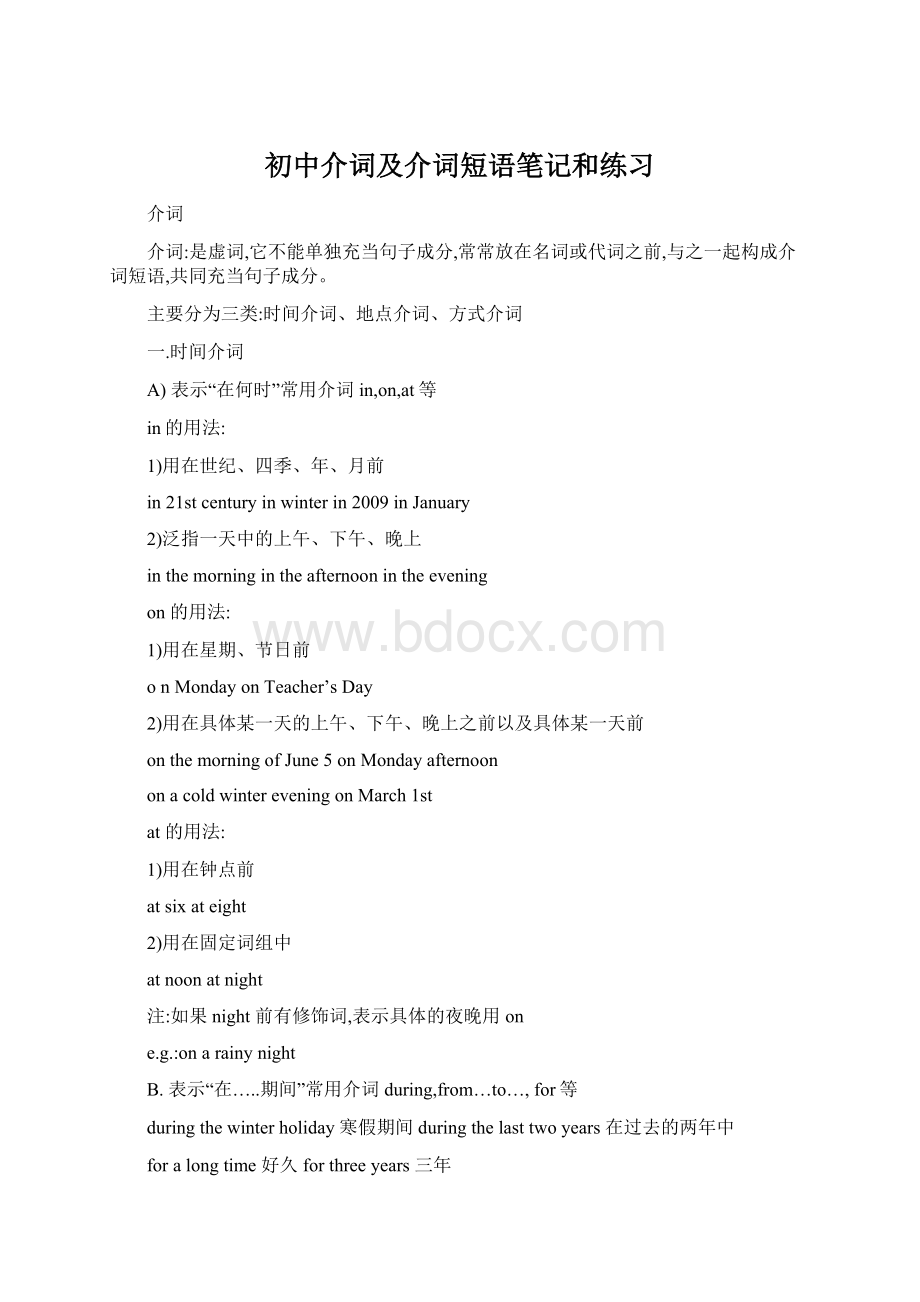初中介词及介词短语笔记和练习Word下载.docx
《初中介词及介词短语笔记和练习Word下载.docx》由会员分享,可在线阅读,更多相关《初中介词及介词短语笔记和练习Word下载.docx(10页珍藏版)》请在冰豆网上搜索。

注:
如果night前有修饰词,表示具体的夜晚用on
e.g.:
onarainynight
B.表示“在…..期间”常用介词during,from…to…,for等
duringthewinterholiday寒假期间duringthelasttwoyears在过去的两年中
foralongtime好久forthreeyears三年
fromMondaytoFridayfromJulytoAugust
C.其它表示时间介词
1)in与after表示时间“在……之后”
“in+一段时间”表示将来一段时间之后,通常与将来时态(一般将来时和过去将来时)连用。
“after+一段时间”表示一段时间之后,通常与过去时连用
e.g.Ihearhe’llbebackinamonth.
Mr.Black.gottoHangzhouafterafewdays.
2)before与after都常用于时间点前
before表示“在……之前,早于……”
1
after表示“在……之后”(与时间点连用表示将来某个时间之后)
e.g.I’llbefreebeforefiveo’clocktomorrow.
ShealwayswatchesTVaftersupper.
I’llringyouupaftertwoo’clock.
3)since与for常用于现在完成时中引导时间状语。
since用于时间点前for用于时间段前
e.g.Hehasbeenateachersince1995.
Shehaslivedherefor20years.
4)by与since表示时间的用法.
by表示一个瞬间动作发生在某一时间点或在某一时间之前.
Since表示从以前某时一直到现在仍在继续,一般只用于完成时态的句子中。
e.g.JackhasstudiedChineseinthisschoolsince2000.
Allofusmustbeattheschoolgatebysixtomorrowmorning.
我们大家都得在明天早上6点钟之前到达学校门口。
5)until与till意为“直到……”常用于not…until…结构中。
表示“直到……才……”,until后跟时间点。
e.g.Themeetingwilllasttillfouro’clock.会议一直开到4点。
Shedidn’tleavetheswimmingpooluntilclosingtime.她直到关门时才离开游泳池。
6)between常与and连用。
表示“在……之间”,后跟表示“时间点”的名词。
e.g.ShewasatMiddleSchoolbetween1979and1985.
习题:
1.Ginawasborn________1999.Sheisoldenoughtogotoschool(06中考)
A.to
B.on
C.at
D.in
2.WetraveledallnighttoLondonandgotthere________Sundaymorning.(07中考)
A.for
D.to
3.Peterusuallygetsupearly________themorning.(08中考)
A.on
B.in
D.of
4.Iusuallydosomecleaning________Sundaymorning.(10朝阳一模)
A.in
B.at
C.on
5.LiLeioftengoestoschool________7:
10inthemorning.(10海淀一模)
A.at
B.for
C.on
D.in
6.Whatahealthlyboy!
Heruns________themorningeveryday.(10海淀二模)
A.in
B.on
C.at
D.for
7.—Whenwasthesportsmeetingheld?
—________April28.(10宣武一模)
A.To
B.At
C.On
D.In
8.Iusuallygetup________eighto’clockonweekends.(10朝阳二模)
A.at
C.in
D.to
9.Ioftenstayathome________Sunday.(10通州二模)
D.with
10.Father’sDaywillcome________June20ththisyear.(10西城一模)
C.in
11.Einstein,thefamousscientist,wasborn________March,1892.(09中考)
12.SomevolunteersfromBeijingarrivedinShanghai________April29toworkfortheWorld
Expo.(10中考)
A.on
B.at
C.of
13.MyuncleiscomingtoBeijing________themorningofMay15.(10东城一模)
14.Ihavesevenclasses________Monday.It’sreallyabusyday.(10丰台一模)
C.of
D.on
15.Mr.Blackisahardworkingengineer.Heoftenstaysuplate________night.(10东城二模)
C.about
二.地点介词
A.in,at与on表示方位用法
in表示地点,“在……内”,用于内部。
at表示“在某地”时,后接小地方,大地方用in。
on“在……上面,在靠近……的地方”,用于表面接触,指在一个平面上。
onthewall“在墙表面挂着”inthewall“在墙内”
Thereisaholeinthewall.
表示树上结出果实用on,外来之物停、落在树上用in.
B.in,on和to表达地区方位
in:
表示某地在一个大的地区范围内的某一方位。
e.g.ShandongisintheeastofChina.
on:
表示两地区的毗邻或“在……之畔”用on
e.g.KoreaisontheeastofChina.
to:
在某地范围之外的某个方向用to
e.g.JapanistotheesatofChina
C.across,over与through
across:
强调从某个平面的一边到另一边,“横过”
through:
指从某个立体空间内穿过,顺着通过……
over:
侧重越过某种障碍物等
e.g.TheGreatWallgoesfromwesttoeast,acrossthedesert,overthemountains,throughthevalleys,
tillitarrivesatthesea.
长城从西到东,穿过沙漠,越过高山,跨过深谷,直达海边。
D.“上面”、“下面”的表达
表示在上方,强调在物体的正上方。
under:
表示在下方,强调在物体的正下方。
above:
表示在上方,不一定是正上方,有时也可指温度、海拔等的刻度。
below:
表示在下方,不一定是正下方,有时也可指温度、海拔等的刻度。
e.g.Look,you’llseeabridgeovertheriver.
Wecanseeavillagebelowthemountainwhenwestandonthetopofthehill.
E.英文中某些动词其后要接人,然后接“介词+the+身体部位”
如果身体部位较软用in,硬的部位用on
e.g.JohnhitJackintheface.
Hecaughttheboybythearm.
1.Lookatthemap________China________thewall,please.
A.of;
in
B.in;
on
C.of;
2.Therearetwowindows________therightwall,thereisamap________theleftwall.
A.in;
C.on;
D.on;
3.Alittlemonkeyisplaying________atreeandtherearealotofbananas________
it.
A.on;
D.in;
4.Shanghaiis________thewestofJapan.
A.to
B.in
D.at
5.HongKongis________thesouthofChina,andMacaois________thewestofHongKong.
to
B.to;
C.to;
6.DoyouknowthatFujianis________thewestofTaiwan?
三.方式介词
A.in指使用某种语言、工具的具体类型等。
with:
多指用工具,用身体的某部位或器官。
e.g.Youcanseeitwithyourowneyes.
by:
指使用的方法和手段。
B.by,in,on表旅行方式时的用法
by+交通工具前面没有冠词或任何修饰语
1)不涉及表示交通工具的名词时用by
bysea海陆byair空运,乘飞机byland陆路bywater水路
2)涉及表示交通工具的单数名词
bycar乘汽车bybus乘公交车bytrain乘火车
byplane乘飞机byship乘轮船bybike乘自行车
byboat乘船bysubway乘地铁
on或in+交通工具确定的交通工具
交通工具前应有冠词、物主代词、指示代词等修饰语。
inacar乘汽车inatrain乘火车
onabusonabicycleonmybike
注意:
但步行用onfoot
C.表示“制造”的表达
bemadein+产地bemadeinto+产品
bemadeof+材料(没有改变性质)从表面可看出原材料
bemadefrom+材料(改变性质)从表面无法看出原材料
bemadeby“由……制成”(人或方式)
bemadefor“制成用于……”
1.Hemakesaliving________teaching.
B.of
C.by
D.on
2.Thebookwaswritten________English.
B.with
C.from
D.by
3.Igotoschool________buseverymorning.
B.by
4.ThisprogrammewassenttotheUSA________China________satellite.
of
B.of;
C.from;
by
D.by;
from
5.IlearnFrench________theradioeveryday.
D.with
6.Thiskindoftableismade________plastic.
A.from
7.—Yourcoatlooksnice.Isit________cotton?
—Yes.It’s________Shanghai.
A.madeof;
madeby
B.madeof;
madein
C.madefor;
D.madefrom;
madeby
四.其它介词
except,but,besides
except=but“除了……之外”不包含,排除之外。
besides“除……之外,另外还有”,着重于“另外还有”(包含在内)
e.g.DoyouknowanyotherforeignlanguagebesidesEnglish?
一)的答案:
1.D2.B3.B4.C5.A6.A7.C8.A9.C10.A11.B12.A13.B14.D15.A
二)的答案:
1.D2.A3.B4.A5.A6.A
三)的答案:
1.C2.A.3.B4.C5.A6.B7.B
6